Jaipur
 Jaipur is a perfect holiday destination with its range of tourist spots and easy accessibility. This historic city was founded in 1727 AD by Sawai Jai Singh II, the city still has its historic charm. It was the first well planned and designed city of India. The whole city is painted with a special shade pink colour and is popular know as the pink city. It attracts millions of tourist every year, every fourth foreign tourist lands to Jaipur. This is just because Jaipur is so beautiful, romantic and modern city. You’ll see a so many Palaces, forts, gardens, museum, monuments, amusement parks, restaurants, bars, hotels, shopping malls, handicrafts, jewelry and garment markets, food markets, multiplexes. Jaipur is ideal destination fun and shopping.
Jaipur is a perfect holiday destination with its range of tourist spots and easy accessibility. This historic city was founded in 1727 AD by Sawai Jai Singh II, the city still has its historic charm. It was the first well planned and designed city of India. The whole city is painted with a special shade pink colour and is popular know as the pink city. It attracts millions of tourist every year, every fourth foreign tourist lands to Jaipur. This is just because Jaipur is so beautiful, romantic and modern city. You’ll see a so many Palaces, forts, gardens, museum, monuments, amusement parks, restaurants, bars, hotels, shopping malls, handicrafts, jewelry and garment markets, food markets, multiplexes. Jaipur is ideal destination fun and shopping.
HOW TO REACH
By Air :- Jaipur has international airport and is well connected to all major cities like Delhi, Jodhpur, Udaipur, Aurangabad, Bombay, Varanasi, Calcutta, Ahmedabad etc. There are so many frequent flights provided by Indian Airlines, Jet Airways and Air Deccan.
By Rail :- Jaipur has broad gauge lines, so it is connected by rail with all major cities like Delhi, Agra, Ahmedabad, Ajmer, Abu Road (Mount Abu), Udaipur, Bombay and Sawai Madhopur.
By Road :- Good motorable roads connect Jaipur with Delhi 258 km, Agra 236 km, Bikaner 321 km, Udaipur 405 km, Ajmer 131 km, Jodhpur 316 km, Bharatpur 176 km, Jaisalmer 638 km and Bombay 1202 km
WHEN TO GO
Best time to travel Jaipur is October to March.
WHAT TO SEE
Jaipur has so many incredible forts and monuments, the major ones are listed below.
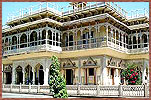 City Palace - The royal palace is located in the heart of pink city. The palace tells the story of the pride and glorious past of Jaipur. A part of the palace is still the residence of the royal family and other part is a famous musems and galley displaying some of amazing antiques, paintings, and artworks. The palace also has a restaurant where you can enjoy the royal taste. The palace is worth visiting.
City Palace - The royal palace is located in the heart of pink city. The palace tells the story of the pride and glorious past of Jaipur. A part of the palace is still the residence of the royal family and other part is a famous musems and galley displaying some of amazing antiques, paintings, and artworks. The palace also has a restaurant where you can enjoy the royal taste. The palace is worth visiting.
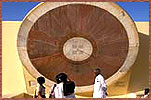 Jantar Mantar - It was built by Maharaja Sawai Jai Sigh II , who’s hobby was astrology and numerology. It the bigest and best preserved observatory among the the other four. By means of the instruments here, astronomers could measure the positions of the stars and calculate eclipses.
Jantar Mantar - It was built by Maharaja Sawai Jai Sigh II , who’s hobby was astrology and numerology. It the bigest and best preserved observatory among the the other four. By means of the instruments here, astronomers could measure the positions of the stars and calculate eclipses.
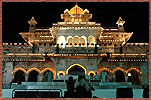 Albert Hall & Museum - It is a beautiful royal hall surrounded by lush green gardens and lawns, located just out side the walled city. The spot is loved by the tourist and local joggers. The enter of attraction, the albert hall is museum displaying a rich collection of Art- de- fact like paintings, carpet, ivory, stone and metal sculptures and colourful crystal works etc.
Albert Hall & Museum - It is a beautiful royal hall surrounded by lush green gardens and lawns, located just out side the walled city. The spot is loved by the tourist and local joggers. The enter of attraction, the albert hall is museum displaying a rich collection of Art- de- fact like paintings, carpet, ivory, stone and metal sculptures and colourful crystal works etc.
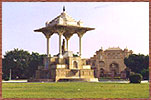 Statue Circle - This is a famous circle, ideal for evening out with friends and family. It has a beautifully carved statue of Maharaja Sawai Jai Singh II.
Statue Circle - This is a famous circle, ideal for evening out with friends and family. It has a beautifully carved statue of Maharaja Sawai Jai Singh II.
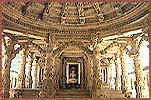 Moti Dungari - Moti Dungari is a privately owned hilltop fort built like a Scottish castle. The Ganesh Temple at the foot of the hill and the marvelous Lakshmi Narayan Temple built in marbles a few years back, are also noteworthy.
Moti Dungari - Moti Dungari is a privately owned hilltop fort built like a Scottish castle. The Ganesh Temple at the foot of the hill and the marvelous Lakshmi Narayan Temple built in marbles a few years back, are also noteworthy.
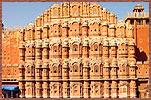 Hawa Mahal - The wind palace was built in 1799 AD. It is the part of the City palace and was bulit for the royal ladies to have glimpses of the royal processions and the market activates.
Hawa Mahal - The wind palace was built in 1799 AD. It is the part of the City palace and was bulit for the royal ladies to have glimpses of the royal processions and the market activates.
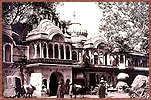 Gaitore - It is the final resting place of the Maharajas of Jaipur and is located just off the Jaipur – Amber Road. Situated in a narrow valley the cenotaphs of the former Maharajas are chhatris made in typical Rajput architecture. The chhatri of Sawai Jai Singh II is of special mention for its carvings that exaggerate it.
Gaitore - It is the final resting place of the Maharajas of Jaipur and is located just off the Jaipur – Amber Road. Situated in a narrow valley the cenotaphs of the former Maharajas are chhatris made in typical Rajput architecture. The chhatri of Sawai Jai Singh II is of special mention for its carvings that exaggerate it.
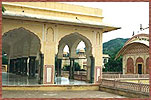 Kanak Vrindavan - Not so old but definitely an exquisitely landscaped gardens with beautifully carved temple in beige stone, which is a vast complex with terrace sites all around and intricately carved marble columns and lattices. Located in the foothills of Nahargarh hills on the way towards Amer, this complex is a popular spot for picnic and film shoots. It should be definitely visited on the way to the three garland forts of Jaipur- Nahargarh, Jaigarh and Amber. The greenery after the monsoons give this whole place a feel of heavenly sensation, with JAL MAHAL in the back ground.
Kanak Vrindavan - Not so old but definitely an exquisitely landscaped gardens with beautifully carved temple in beige stone, which is a vast complex with terrace sites all around and intricately carved marble columns and lattices. Located in the foothills of Nahargarh hills on the way towards Amer, this complex is a popular spot for picnic and film shoots. It should be definitely visited on the way to the three garland forts of Jaipur- Nahargarh, Jaigarh and Amber. The greenery after the monsoons give this whole place a feel of heavenly sensation, with JAL MAHAL in the back ground.
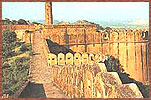 Jaigarh Fort- It was built in 1726 AD and was never captured. The fort is is well maintained and houses a mammoth cannon called Jai Ban and has extensive walls.
Jaigarh Fort- It was built in 1726 AD and was never captured. The fort is is well maintained and houses a mammoth cannon called Jai Ban and has extensive walls.
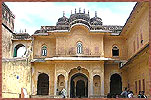 Nahargarh Fort - Narahgarh means the abode of Tiger, it is located in a roughed Aravali hills. The fort has wonderful view of The pinkcity. It was built in 1734 and was the excursion spot for the royal family.
Nahargarh Fort - Narahgarh means the abode of Tiger, it is located in a roughed Aravali hills. The fort has wonderful view of The pinkcity. It was built in 1734 and was the excursion spot for the royal family.
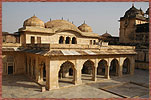 Amber- The stunning fort is the famous fort of Jaipur. It was built by Maharaja Mansingh. It displays a unique blend of Rajasthani and Mughal architcture. The fort features a lake which reflects its many terraces and pavilions. Amber is also known for the spectacular Sheesh Mahal, Jai Mandir, Diwan-i-Am, Sikh Niwas and the small Kali Temple.
Amber- The stunning fort is the famous fort of Jaipur. It was built by Maharaja Mansingh. It displays a unique blend of Rajasthani and Mughal architcture. The fort features a lake which reflects its many terraces and pavilions. Amber is also known for the spectacular Sheesh Mahal, Jai Mandir, Diwan-i-Am, Sikh Niwas and the small Kali Temple.
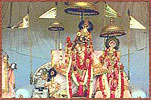 Govind Devji Temple - The most popular temple of Jaipur dedicated to Lord Krishna. It is located in the central pavilion of the Jai Niwas Garden to the north of Chandra Mahal. The image of the patron deity-Govind Devji,originally installed in a temple of Vrindavan, was reinstalled here by Sawai Jai Singh II as his family deity.
Govind Devji Temple - The most popular temple of Jaipur dedicated to Lord Krishna. It is located in the central pavilion of the Jai Niwas Garden to the north of Chandra Mahal. The image of the patron deity-Govind Devji,originally installed in a temple of Vrindavan, was reinstalled here by Sawai Jai Singh II as his family deity.
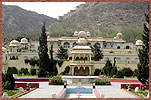 Sisodia Rani Garden - It has tiered multilevel gardens with fountains, water channel and painted pavilions and suites of living rooms.
Sisodia Rani Garden - It has tiered multilevel gardens with fountains, water channel and painted pavilions and suites of living rooms.
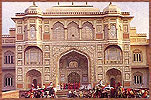 BM Birla Planetarium - The Planetarium offers unique audio-visual education and entertainment with its modern computerized projection system. For school groups concessions are available. Closed on last Wednesday of every month. It opens from 12.00 PM to 19.00 PM.
BM Birla Planetarium - The Planetarium offers unique audio-visual education and entertainment with its modern computerized projection system. For school groups concessions are available. Closed on last Wednesday of every month. It opens from 12.00 PM to 19.00 PM.
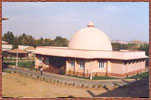 Galtaji - An ancient pilgrimage centre, lying beyond the gardens amidst low hills temples ,pavilions and holy kunds (natural spring and reservoirs) along with lush landscape make it a delightful spot. The small temple of the Sun god, built by Diwan Kriparam on the top of the highest peak is visible from all parts of the city.
Galtaji - An ancient pilgrimage centre, lying beyond the gardens amidst low hills temples ,pavilions and holy kunds (natural spring and reservoirs) along with lush landscape make it a delightful spot. The small temple of the Sun god, built by Diwan Kriparam on the top of the highest peak is visible from all parts of the city.
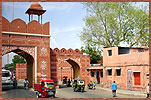 Old City - Once a settlement of nobles, craftsmen and common folks, the city of Amer is now in ruins. The remnants of its rich past are the beautifully carved and planned Jagat Shiromani Temple, a Krishna temple associated with Meerabai, an ancient temple of Narsinghji and a magnificent step-well, Panna Mian-ka-kund.
Old City - Once a settlement of nobles, craftsmen and common folks, the city of Amer is now in ruins. The remnants of its rich past are the beautifully carved and planned Jagat Shiromani Temple, a Krishna temple associated with Meerabai, an ancient temple of Narsinghji and a magnificent step-well, Panna Mian-ka-kund.
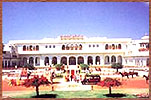 Ram Niwas Bagh - A lush spacious garden with a zoo, an aviary, a greenhouse, a herbarlum , a museum and popular sport ground. It was built by Sawai Ram Singh II in the 1868 A.D. as a famine relief project. The Albert Hall-fine example of Indo Saracenic style of architecture designed by Sir Swinton Jacob, was opened later with an exquisite collection of sculptures, paintings, decorative wares, natural history specimen, and Egyptian mummy and the celebrated Persian carpet.
Ram Niwas Bagh - A lush spacious garden with a zoo, an aviary, a greenhouse, a herbarlum , a museum and popular sport ground. It was built by Sawai Ram Singh II in the 1868 A.D. as a famine relief project. The Albert Hall-fine example of Indo Saracenic style of architecture designed by Sir Swinton Jacob, was opened later with an exquisite collection of sculptures, paintings, decorative wares, natural history specimen, and Egyptian mummy and the celebrated Persian carpet.
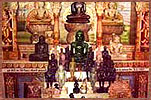 Jain Temple - The exquisite Jain temple on the Agra road has some of the most beautiful 19th century paintings in Jaipur style on its walls.
Jain Temple - The exquisite Jain temple on the Agra road has some of the most beautiful 19th century paintings in Jaipur style on its walls.
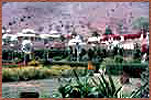 Ghat ki Guni - Beautifully landscaped gardens, laid out in the 18th and 19th century by king and courtiers dot the narrow gorge in the south eastern corner of the walled city, along the road to Agra.
Ghat ki Guni - Beautifully landscaped gardens, laid out in the 18th and 19th century by king and courtiers dot the narrow gorge in the south eastern corner of the walled city, along the road to Agra.
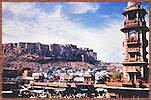 Swai Ishwari - Singh who was cremated outside the Jai Niwas Garden. Most imposing is the ‘chattri’ of Sawai Jai Singh II with the intricate carvings and a graceful shape.
Swai Ishwari - Singh who was cremated outside the Jai Niwas Garden. Most imposing is the ‘chattri’ of Sawai Jai Singh II with the intricate carvings and a graceful shape.
Swargasuli (Isar Lat) - The highest tower dominating the skyline of the western side of the Tripolia Bazaar. It was built by Sawai Ishwari Singh in 1749 A.D. to commemorate a grand victory.
SHOPPING
Jaipur is famous for its lacquer jewellery, painted with enamel, encrusted with Kundan.
You can find precious and semi-precious stones including garnets, emeralds, rubies, topaz and amethyst are also very popular with tourists. Tie-and-dye work on silk and crepe and the Sanganer block prints are the specialties of Jaipur. Large and small units of block and screen printers at Sanganer village (on Tonk Road near the airport) produce some of the finest hand-printed textiles. You can purchase Sanganer bed linen, table linen and dress material on a variety of fabrics in the village or at any outlet in the Pink City. Ethnic block prints, traditional crafts of Rajasthan from the shops at MI Road. While in Sanganer, don’t forget to check out Jaipur blue pottery. The thumb rule for bargaining at roadside stalls still operates here. So you can make some good buys. The Jaipuri razai is also very popular.
WHERE TO EAT
There are so many good restaurants and bars, you’ll find few international restaurants.
Panghat packs dinner and traditional entertainment together, in a cocktails and Tandoori fare at the Taj Rambagh’s amphitheatre.
Suvarna, also at Rambagh, is a multi-cuisine restaurant.
Lakshmi Misthaan Bhandaar, popularly known as LMB, gives you Rajasthan on a plate including their renowned ‘ghewar’.
Copper Chimney - It offers a deal of Rs 200-Rs 250 per person for any course (vegetarian or non-vegetarian).
Pizza Hut is at the Ganapati Plaza (Tel: 388 627 for free home delivery) For a taste of real Rajasthan, complete with heat and dust, drive out to Tonk Road.
Chokhi Dhani - Serves delicious Rajasthani vegetarian meal, laced with desi ghee with traditional style of bajot setup. While there you can also watch folk performances or go on a camel ride.








